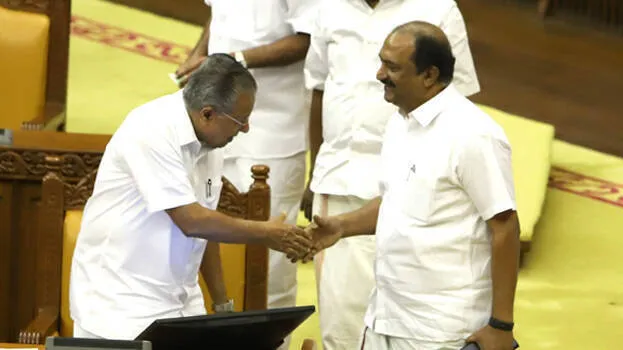

The last full budget of the second Pinarayi government presented by Finance Minister KN Balagopal in the Legislative Assembly yesterday did not announce major welfare benefits as expected. However, it is rich in investment plans aimed at development. Given the state's current financial situation, it is not feasible for any finance minister to announce large-scale benefits that would further strain the economy. He began his speech with the statement that the budget would focus on projects that contribute to the state's overall progress. The minister went on to claim that despite having to face the Union government's adverse financial policies, the state was able to overcome the crisis. The budget allocates the expected revenue of Rs 1.52 lakh crore across various departments and sectors.
While new investment projects were given priority, revenue generation measures included an increase in court fees, certain vehicle taxes, and a 50% hike in land tax. These measures are expected to bring in only an additional Rs 366 crore in revenue. Considering the severe financial crunch the state is facing, other avenues for resource mobilization could have been explored. The upcoming local body elections and the assembly elections next year might have influenced the finance minister to present a risk-free budget to avoid public discontent.
Apart from the announcement that the pending three instalments of welfare pensions will be disbursed soon, there was no mention of an increase in pension amounts. The 6.2 million pensioners had at least expected a modest hike in their benefits.
However, there was some relief for government employees and teachers regarding the pending dearness allowance (DA) arrears and the announcement of a new DA instalment. Additionally, pending pension arrears will also be settled soon. The lock-in period for DA arrears will not be extended, and a fresh DA instalment will be sanctioned. However, other demands of government employees were not addressed. There were no announcements regarding a new pay commission, the contributory pension scheme, or the Medisep health insurance scheme, likely due to the financial crisis.
A Rs 750 crore rehabilitation project for Wayanad has been included in the budget to help the district recover from the devastating landslides that shook Kerala’s conscience. The landslides in Mundakkai and Chooralmala in Wayanad caused damages worth Rs 1,202 crore. Since the central government has not provided any assistance for the rehabilitation efforts, the state has had to take up the Rs 750 crore project on its own.
The Finance Minister stated that the state is on a path of rapid growth. Significant progress has been made in infrastructure development, and the budget emphasizes development projects that cover all sectors. The idea of a high-speed rail corridor has not been abandoned. Metro rail projects in Thiruvananthapuram and Kozhikode will proceed as planned. The minister announced that preliminary steps for the Thiruvananthapuram metro would begin this year itself. There are also discussions about setting up a new shipyard in Thiruvananthapuram. The emergence of new industrial corridors linked to the Vizhinjam port is expected to bring substantial progress. Considering the growing urban population, metropolitan councils will be established in Thiruvananthapuram, Kochi, and Kozhikode. This will serve as a precursor to the formation of metropolitan authorities. Let us hope that these projects do not become another failed venture.
The two-and-a-half-hour-long budget speech introduced a flood of projects. One innovative initiative is the conversion of unoccupied houses in the state into homestays for tourists, under the name 'K-Homes.' This project will be implemented in tourism hotspots such as Fort Kochi, Munnar, Kumarakom, and Kovalam. An allocation of Rs 10,431 crore has been made for local self-governing bodies, which should be sufficient to ensure regional development. However, if fund cuts occur towards the end of the financial year, as has happened before, the objective may not be achieved. There has been a consistent failure in effectively utilizing local body funds, with some institutions unable to spend even half of their allocation by the end of the financial year. The Rs 700 crore set aside for the Karunya healthcare scheme may not even be enough to clear pending hospital dues.
Some of the key budget allocations include Rs 3,061 crore for bridges and roads, Rs 1,160 crore for the LIFE housing project, Rs 2,278 crore for the agriculture sector, Rs 150 crore for paddy cultivation, Rs 295 crore for the fisheries sector, Rs 297 crore for Kudumbashree, Rs 100 crore for Kuttanad development, Rs 1,831 crore for industries, Rs 100 crore for electricity development, Rs 266 crore for the technical university, Rs 402 crore for the midday meal program and Rs 2,063 crore for food security. However, the allocations may not be sufficient to undertake new projects or ensure overall development. The struggling Kerala State Road Transport Corporation (KSRTC), which has long been in financial distress, has also been given a significant share. Rs 178 crore has been allocated, along with an additional Rs 100 crore for the purchase of new diesel buses. At a time when diesel buses are being phased out across the country, Kerala is insisting on acquiring more of them.
The total plan outlay for the current financial year has been set at Rs 32,500 crore. However, with the financial crisis deepening, budget cuts may primarily affect development projects, making the size of the allocation less significant.
The Finance Minister stated that housing societies would be formed to construct homes for middle-income groups in urban areas. A total of one lakh houses will be built under this initiative. The budget made no mention of the controversial KIIFB toll collection. However, the indication that KIIFB will be transformed into a self-sustaining revenue-generating institution suggests that toll collection remains the ultimate goal.
With 65% of the state's revenue being spent on salaries, pensions, and interest payments, there is little left for development projects and other needs. Like a financially constrained head of a household, the only option is to spend frugally. This is precisely what the Finance Minister has attempted to do.